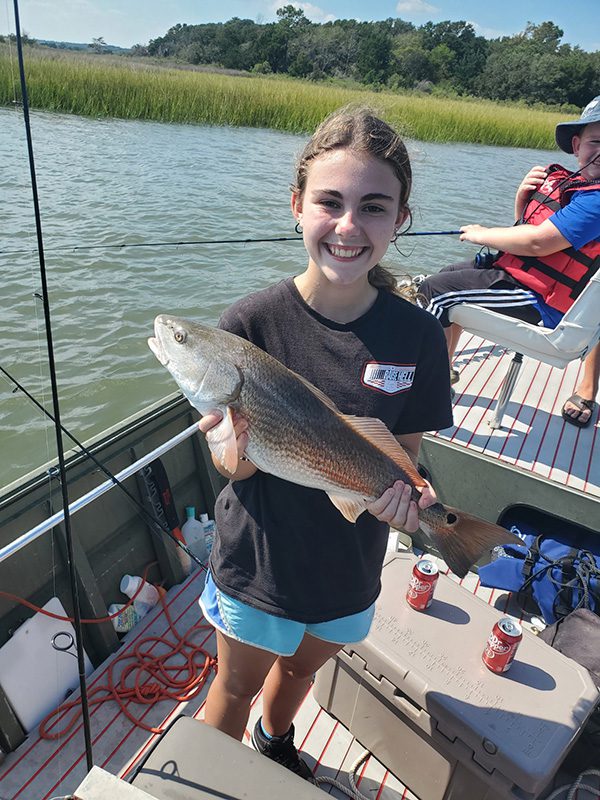North Myrtle Beach/Little River – March 2023
Patrick, of Captain Smiley Fishing Charters, reports that anglers fishing the Little River jetties are having success finding speckled trout, with live shrimp producing most of the action. Using the same live shrimp on bottom rigs along the rocks will also get strikes from red and black drum.
Fishing off the beach can be really hit-or-miss in these cooler winter months. Anglers taking advantage of weather windows are finding black drum, bluefish, and plenty of black sea bass at the Caudle Reef and similar nearshore structures.
Moving into March, speckled trout will get more active and start moving into areas along the ICW. Live shrimp will be the best bait to entice strikes from these fish just moving out of their lethargic winter patterns.
Red drum will be holding up in the creeks until warmer water temperatures get more bait moving into the area.
Bob, of Strange Magic Fishing Charters, reports that speckled trout are a top target, with soft plastics and suspending lures having the best success. The trout will also strike at jigs or live mud minnows under a popping cork.
Red drum can be difficult to find in the late winter as both under-slot and slot-sized fish school up in large groups in the backs of creeks. These fish see a lot of pressure from anglers, birds, and dolphins, so patience and stealth are key. Make casts outside the schools so as to not spook the fish. Anglers are finding Gulp or Z-Man soft plastics to be great scouting lures for back in these creeks. Moving into spring, the red drum break out into smaller groups and are back to their typical aggressive-feeding selves.
Black drum are also back in the creeks, as well as staged up around docks near creek and marsh drains. The presence of birds or bait can help to pick which docks to target.
Flounder mostly remain at their nearshore and offshore winter haunts. They will start to return inside as water temperatures hover above 60-65 degrees. These fish tend to congregate in similar areas each time they return, so plenty of areas where you have found previous success will produce again.
Chris, of Fine Catch Fishing Charters, reports that anglers getting off the beach into the 5-15 mile range are seeing a good push of black sea bass. Many of the lesser-known live bottoms and ledges in the 50-70’ range have been holding the better-sized fish. Bait choice doesn’t matter much with these aggressive feeders. Just about any cut bait on a double dropper loop rig should produce bites if fish are there. If not looking to use cut bait, large artificials such as Gulp soft plastics and Fish Bites grubs or curly tails on a 2 oz. jig head will get strikes.
Nearshore structure, in the three-mile range, is holding some nice-sized sheepshead and black drum action. Typically, using fiddler crabs or cut shrimp on Carolina rigs or lighter 3/4-1 oz. jig heads will produce bites.
Anglers targeting the jetties are finding a mixed catch of speckled trout, black drum, sheepshead, and red drum. Floating a fresh dead or live shrimp under a slip cork along the rocks is a great way to produce bites from any of these species. If the smaller sheepshead are stealing baits, start casting artificial shrimp or Z-Man swimbaits to target the larger trout and red drum in these rocks. Recent productive color patterns have been clears, purples, and red flake.
The backwater creeks are holding a mix of red drum, speckled trout, and black drum. These fish have seen a lot of fishing pressure and are really spooky. Any baits you throw need to have a low profile and be presented slowly, but some patience can be rewarded with monster fish. Both live mud minnows and shrimp rigged on a jig head work well, as does a lightweight artificial shrimp.
Anglers can find some smaller speckled trout around the shell banks and creek mouths off the ICW. Finding these schools is best by utilizing your electronics, especially side scan, and marking these fish as you cruise along. The trout tend to feed facing the current, so be sure to get baits ahead of them and then work your way back.
Docks in these areas are also holding numbers of black and red drum. Both species are being caught on dead shrimp fished on Carolina rigs or jig heads.
Larry, of Voyager Fishing Charters, reports that signs of spring are starting to show, with better action on the nearshore reefs. The half-day boats are seeing excellent black sea bass fishing, with porgies and small sharks in the mix.
Offshore trolling trips have been finding wahoo and good-sized blackfin tuna.
The deep-water bottom fishing action is about to fire off in the coming weeks. Anglers taking advantage of the warmer weather will be catching vermilion snapper, large porgies, grunts, triggerfish, and amberjacks.
Bevan, of Chilly Water Fishing, reports that the winter black sea bass bite is strong. Plenty of keepers are being caught in the 60’ range, with larger fish out in the 80-100’ area.
Out in the 100’ area, there are also some decent-sized vermilion snapper and triggerfish being landed. Lately, anglers have found they need to race their fish to the boat in order to avoid all the sharks.
On the rare opportunity to run offshore, anglers have found a pretty good blackfin tuna bite, along with scattered wahoo.
Norma, of Apache Pier, reports that bottom rigs tipped with shrimp and a variety of other cut or artificial bait strips are the best bet with water temperatures still cool on the beaches. These baits are producing any mix of croakers, nice-sized whiting, pufferfish, and some bluefish.







